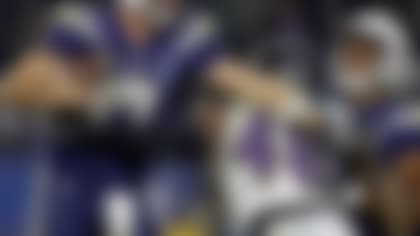Hue Jackson's firing has been a turning point of sorts for a Cleveland Browns team that, at 2-5-1, seemed destined for another forgettable finish and top five position in the upcoming draft.
The Browns' offense was stuck in first gear at best in the final days of the Jackson era, failing to get much of anything going in the passing game. It was an alarming shift after a hot start for rookie quarterback Baker Mayfield. Cleveland braced for more disappointment as the seemingly eternally gray skies in the region set in for a long winter.
But then came a ray of sunshine in the most unexpected form of running backs coach Freddie Kitchens, an NFL veteran who was promoted to offensive coordinator for the first time in his career.
Since Kitchens' promotion, the Browns' offense has taken on a new look, answering prolonged calls for more involvement of running backs in the passing game and injecting life into a unit that was left on life support not too long ago. His approach has been simple: Shorten the passing game and keep defenses honest.
He's doing so by dialing up a healthy dose of screens, swing passes to running backs Duke Johnson and Nick Chubb, and shorter targets for Mayfield. It has created quicker decisions for the rookie, and more run-after-catch opportunities for his receivers.
The numbers reflect the change in a big way.
Mayfield's pressure rate has fallen off a cliff since Kitchens took over play-calling, dropping from 23.9 percent of dropbacks in Weeks 3-8 to 7.8 percent in Weeks 9-12. Cleveland hasn't given up a sack in its last two games, either.
Mayfield's quick throws have increased as well, jumping from 46.2 percent of passes in Weeks 3-8 to 55.7 percent in Weeks 9-12. Target areas for these throws have seen a bump, too, with down-the-seams attempts increasing from 41.3 percent of attempts to 54.4 percent, and behind-the-line-of-scrimmage passes rising from 13.9 percent to 22.7 percent.
As a result, Mayfield's completion percentage has leaped from 58.3 percent in the first period of time to 73.9 in Weeks 9-12. His difference between actual and expected completion percentage has improved tremendously too, from minus-4.2 percent to plus-5.0 percent.
The biggest change has been reflected in his passer rating in four different scenarios: on quick throws (from 89.6 to 136.1), against the blitz (75.7 to 149.5), under pressure (51.9 to 137.1) and on the run (28.4 to 115.3).
Some of these improvements also have to do with Mayfield's rare athletic ability, which allows him to make unlikely throws on the run with unique precision. It is often the reason why Cleveland is successful, with Mayfield extending plays with his feet before firing darts to targets for completions of varying distances.
He completed such a marvelous play against Cincinnati, when guard Kevin Zeitler was beaten by his former teammate, Geno Atkins. Mayfield felt the pressure from his right, stepped up into the pocket and lofted a beautiful pass over the defense to Rashard Higgins for a gain of 24. His touchdown pass to Higgins two weeks earlier was similarly a work of art on the part of a pressured Mayfield.
It's also extremely evident that with more game reps and less pressures/hits taken, Mayfield is improving in both decision-making and overall comfort. Watching his film is a treat, and tantalizing because of how much potential Mayfield possesses. Cleveland might finally, after 20 years, have its man at quarterback.
There's also been a key change at left tackle, one for which Mayfield campaigned in the hours after Cleveland's Week 9 loss to Kansas City, and one that has significantly helped the unit function better. The Browns replaced rookie Desmond Harrison -- an athletic left tackle who has clear raw skills to potentially develop into a starting-caliber tackle but struggled against the blitz and basic edge rushes -- with the older Greg Robinson.
The former No. 2 overall pick in the 2014 draft has been a breath of fresh air and a needed reinforcement on Mayfield's blind side.
While athletic enough to achieve proper depth against edge rushers, the very raw Harrison struggled to remain stout once engaged, often pushed backward by bull rushes. It's something with which right tackle Chris Hubbard also has an issue, but the Browns can't fix both positions at once. With Harrison being the worse of the two, Cleveland opted to insert Robinson in his place after his strong showing in an unexpected start against the Chiefs.
Robinson is much better in such situations, consistent in winning races to the edge and sustaining blocks thanks to a massive upper body that includes powerful, long arms and a frequently reliable, firm base. He moves laterally well while maintaining good balance, and it makes for a difficult challenge for edge rushers attempting to get around him.
This difference was no more apparent than on Mayfield's Week 12 touchdown pass to Antonio Callaway. Mayfield drops back in the pocket and surveys the field while Robinson exhibits excellent hand skills, batting away Carlos Dunlap's attempt to win Robinson's inside shoulder with a long arm and knocking Dunlap off balance. Meanwhile, Hubbard is again knocked backward by a bull rush (it happens frequently) from Michael Johnson, squeezing the right edge of the pocket inward. Mayfield feels this pressure and escapes the pocket to his left, sliding laterally while keeping his eyes downfield and firing a bullet into the back of the end zone for a touchdown.
This extended portion of the play is made possible by Robinson refusing to stop blocking, sticking with Johnson even after he'd pushed him upfield and almost out of the play. His continued block gave Mayfield enough time behind him to step out of the pocket and make the throw, which produced a score for the Browns in a stunning first half that saw them grab a 28-0 lead.
Robinson is, however, susceptible to inside moves. They don't come often, but the first time that became painfully evident was midway through the third quarter in Week 10 vs. Atlanta, when Falcons defensive end Bruce Irvin utilized a spin move inside to beat Robinson. Irvin never made it to Mayfield, because the quarterback got rid of the ball on an incompletion intended for Jarvis Landry down the sideline.
It wouldn't be surprising to see opposing edge rushers employ such a move more often in the coming weeks, as it didn't happen often from Weeks 9-12. Tape doesn't lie and with players studying plenty of it, it's bound to become more prevalent in the final month or so of the season.
Speaking of such attempts, they are one of Mayfield's weak crutches. When faced with a situation in which no other target is clearly open, Mayfield tends to send passes down the sideline to receivers in one-on-one situations. They usually don't pan out, and one of these attempts even ended in an interception against Pittsburgh in Week 8.
But he hasn't had to make such throws as often since, thanks to Kitchens' play calls.
Before expanding further on Kitchens' scheming skills, we must first address the other tackle position. Even on successful plays, Hubbard has an issue with maintaining pocket integrity against bull rushes. On Mayfield's third-quarter touchdown pass to Duke Johnson -- one that essentially put a bow on Cleveland's win over Atlanta -- Hubbard is driven backward right into Mayfield's personal space by Vic Beasley. Fortunately for the Browns, Mayfield delivered the pass to Johnson underneath in just enough time for the rush to be irrelevant.
Browns GM John Dorsey has done a masterful job of remaking the team's roster in one offseason, but the signing of Hubbard looms as a potentially regrettable one, if what is apparent on the film continues to happen moving forward.
Now, back to Kitchens' play-calling. It's the real reason why the Browns have won two straight games.
As the number showed above, Kitchens has pivoted the Browns' offense to a shorter one, with a mix of quick throws and play-action that is often used to keep defenses honest. It was necessary after a stunt-and-blitz-heavy Steelers team caused all kinds of issues for the Browns in Week 8. Since then, opposing defenses have blitzed and stunted less. Kansas City rushed straight up almost exclusively, while Atlanta blitzed more but rarely stunted. Cincinnati didn't find much success at all in pressuring the quarterback, no matter what it tried, as it seemed nearly everything was working for the Browns in the passing game. That was again a testament to play-calling and Mayfield's ability to improvise.
Kitchens has also gotten both creative and courageous, showing little fear in dialing up the same play multiple times to mixed results. He's leaned on one play in particular -- a designed swing pass to the running back out of the shotgun, with three receivers running quick in routes and the farthest receiver on the opposite side of the field running some variation of a streak -- in multiple games. On two straight pass attempts against Atlanta, Kitchens called the play and it worked decently. He called it again against Cincinnati two weeks later, resulting in Chubb's receiving touchdown on a pass that was under thrown by Mayfield.
In between, Kitchens has dialed up a multitude of screens in various forms, even channeling his inner Andy Reid by having one come off a zone action to the right, followed by a fake reverse handoff to Callaway. Mayfield eventually turned back toward Chubb, who slipped out of the backfield after executing the run fake and caught the pass behind center JC Tretter and guard Kevin Zeitler. Tretter blocked Sharrod Neasman out of the play, while Chubb outran linebacker De'Vondre Campbell to the end zone for a touchdown.
Kitchens has also called screens that haven't gone for touchdowns, but have elicited at least one smirk from those watching the tape. Mayfield dropped to pass against Kansas City while Johnson appeared ready to pass block. At the last second, he acted as a matador for Dorian O'Daniel's angry bull, sending him out of the action with an old-fashioned ole before catching the screen pass and running upfield for a gain of 10.
Cleveland opened its Week 12 win over Cincinnati with another screen for a gain of 23. It also found success throwing downfield time and time again off of -- you guessed it -- play-action passes. It seems as though with each week, the offensive personnel and Kitchens become more in sync, and it's producing better performances with each week.
Not all is sunshine and roses in Cleveland (it's actually probably pretty gray and cold there right now), as the Browns still have plenty of work to do up front. Too often, blocking assignments are confused against increased rushes, whether it's between guard and tackle or guard and center. Hubbard has occasionally allowed a free rusher up the middle, leaving Mayfield to work his magic to attempt to salvage a play, and there have been missed assignments elsewhere that have left inside rushers unblocked. Sometimes, it's easier to predict when Cleveland trots out an empty backfield set.
But the insertion of Robinson on the left side has solidified what was once a source of nearly constant pressure and uncertainty for the rookie quarterback. The change, combined with Kitchens' play-calling has produced a much more comfortable and decisive Mayfield -- and multiple victories for a suddenly promising Browns team.











